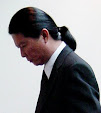This Merdeka, we celebrate the Mah Meri tribe of the Senoi people. The original people of this land aka the Orang Asal. They have lived for centuries off the land in harmony with nature. Their deep reverence for nature has made them renown for their art of carving masks and statues which they use in prayers and ceremonies. Each carving has a folklore linked to natural and benevolent spirits that live amongst us. We're taking a leaf from these people to transcend the physical and political to embrace the spirit that unites us as a nation.
Much like the delegation of diverse, multiracial and multi-talented individuals who journeyed to London in 1956 seeking independence from the British.
“Don’t ask, don’t get.”
This must have been the thought driving our founding fathers as they embarked on their historic journey to London in February 1956, determined to secure our independence from British colonial rule. Armed with meticulous arguments, well-crafted proposals, and a deep understanding of the terms set by the British, they were prepared for the most important negotiation in Malaya’s history.
The delegation was formidable in its resolve and preparation. So persuasive were their presentations, so thorough their negotiations, that independence was secured in a single formal meeting on that chilly February day in London. While the air may have been cold in the British capital, the sun was undoubtedly shining brightly over Malaya.
Malaya, or Tanah Melayu, was granted independence that very month, with the official date set for August 31, 1957. And as they say, the rest is history.
Let us pay homage to the elite team who journeyed to London and returned with our freedom:
1. Tunku Abdul Rahman
• Position: Chief Minister of the Federation of Malaya and leader of the delegation.
• Role: Tunku Abdul Rahman was the head of the delegation and the primary negotiator. He was also the President of the United Malays National Organization (UMNO) and would later become the first Prime Minister of independent Malaya.
2. Tun Abdul Razak Hussein
• Position: Minister of Education.
• Role: Abdul Razak was an important figure in the negotiations, representing UMNO. He would later serve as the second Prime Minister of Malaysia.
3. Tun Dr. Ismail Abdul Rahman
• Position: Minister of Commerce and Industry.
• Role: Dr. Ismail was a prominent leader who played a key role in the negotiations and was instrumental in shaping post-independence policies. He later became the Deputy Prime Minister of Malaysia.
4. Tun Tan Cheng Lock
• Position: President of the Malayan Chinese Association (MCA).
• Role: Representing the Chinese community, Tan Cheng Lock was an essential figure in ensuring that the interests of the Chinese population were considered in the independence negotiations.
5. Tun V.T. Sambanthan
• Position: President of the Malayan Indian Congress (MIC).
• Role: As the representative of the Indian community in Malaya, Tun Sambanthan was responsible for advocating for the rights and interests of the Indian population in the new nation.
6. Dato’ Abdul Razak bin Dato’ Hussein
• Position: Minister of Education.
• Role: Dato’ Abdul Razak played a significant role in the negotiations, particularly in discussions related to education and administration.
7. Dato’ Wong Pow Nee
• Position: Chief Minister of Penang.
• Role: Representing Penang, Dato’ Wong Pow Nee was involved in the negotiations to ensure that the interests of the state and its people were addressed.
8. Colonel Tun H.S. Lee
• Position: Minister of Transport.
• Role: As a representative of the MCA and a key member of the Alliance Party, Colonel H.S. Lee contributed to the discussions on infrastructure and transport policies for the new nation.
These delegates were part of the Alliance Party, a coalition representing the three major ethnic groups in Malaya (Malays, Chinese, and Indians). The successful negotiations in London led to the agreement on Malaya’s independence, which was officially granted on August 31, 1957. *
This diverse group of talented individuals, representing a cross-section of our nation, laid the foundation for the country we now know and love as Malaysia.
The Malaysia We Know – And Love
However, the Malaysia we see today is but a shadow of the nation we were in the decades following Merdeka. While we have enjoyed political freedom for 67 years, the journey toward achieving true spiritual independence—'Jiwa Merdeka’—remains unfinished.
This theme resonates deeply in this year's Merdeka celebrations.
What does ‘Jiwa Merdeka’ truly mean?
At its core, spiritual independence was the very essence of our founding fathers’ vision. They understood that our greatest strength lies in our diversity. Our multiracial composition demonstrated to the British that we could govern ourselves with peace, harmony, and prosperity. It was this very criterion—the ability to unite despite our differences—that convinced the British to grant us independence. The diverse composition of our delegation, coupled with the merit of our negotiations, sealed the deal.
Our multicultural society is the lifeblood of our nation, and our existence as a progressive country hinges on it. Yet, the ever-looming clouds of race, religion, and colour threaten this vision. ‘Jiwa Malaysia’ or spiritual independence, calls us to transcend these divides and embrace a collective spirit that sees beyond physical and political distinctions.
That is the true spirit of Merdeka—*Jiwa Merdeka*.
Happy Merdeka to all.
Visual rationale:
The Mah Meri tribe belongs to the Senoi people, one of the indigenous peoples of Malaysia, renowned for their ancient mask carvings from the wood of the blackboard tree for use in celebrating festive occasions like weddings. The masks embody benevolent spirits that, in the animistic pantheon of the Mah Meri, are used to drive away evil, soul-stealing spirits.
Source: https://www.maskmuseum.org/mask/mah-meri-moyant-kuhau/
Visit them online to discover their amazing story here: https://www.mmcv.org.my/fully-customizable-2/
*Handcrafted by human, verified and cleaned up by ChatGPT4.
Sources; "The Making of the Malayan Constitution" by Joseph M. Fernando >https://www.mbras.org.my/monograph31.html
"The End of Empire and the Making of Malaya" by T.N. Harper >https://www.cambridge.org/core/books/abs/end-of-empire-and-the-making-of-malaya/introduction/6D87C369666F27067AB19D136F2E1FAE







No comments:
Post a Comment